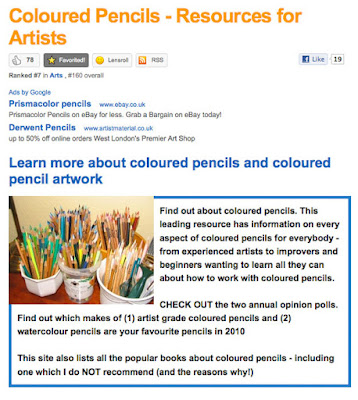This is an initial overview of a new site called Paint My Photo - for those interested in painting from photos who also want to be able to access reference photos taken by other people to do this.
A number of art forums have created photographic resources for their members - notably
Wet Canvas's
Reference Image Library (although this has been inaccessible for long periods on occasion).
A new site has started up on Ning - apparently independently of any major corporate interests which is interesting of itself - and it's all about painting from photos
Not only that but it's set up deliberately to create a pool of photos for other people to use - and hence is called
Paint My Photo (
subtitle - Where photographers and artists meet). The intention is that reference photos supplied by photographers are copyright free and hence can be used by artists to produce art which they can sell without a fee to the photographer.
 |
| Paint My Photo can be found at http://paintmyphoto.ning.com/ |
The site seems to have been set up earlier this year and this is how it describes itself.
What's The Idea?
Very Simple, there are lots of great Photographers out there in internet land, and there are lots of Artists of all abilities who would like to paint from photographs. The problem is that Copyright law prevents this, although many photographers would love to inspire other Artists (Yes I do agree photography is an Art, I chose the terms 'Artists' and 'Photographers' for clarity). So-If you have posted photographs here, it is because you are happy to allow derivative works to be created. You still own the copyright of your photos of course. The Artist can, if the photographer has selected that option on joining, contact the Photographer to enable them to see the work. The Artist can sell their work as normal, if the photographer wants 'first refusal' on the Artwork, that should be by private arrangement and has nothing to do with 'Paint My Photo'. Artists can place links to where there work can be purchased. Photographers can place links to where other work and prints can be purchased. Anyone spamming and not following the spirit of the site will be warned and advised before any action taken.
****IMPORTANT!****
We are a site for natural media only, no digital artwork, thanks for sticking to this rule.
Features of 'Paint My Photo'
Here are some of the features I could pick out:
- over 7,000 photos already loaded onto the site. However it's a little puzzling as the reference photos are mixed up with the digital images of the artwork created as a result so it's unclear how many photos there are altogether
- 442 members to date - suggesting it's got enough to keep going
- 22 videos loaded - usually by reference to a link to YouTube where people have chosen to share their videos
- a monthly challenge - which tends to be a very popular feature on many of the forums targeting leisure artists.
- a forum - of the conventional sort with categories and threads. This isn't as well advanced as I'd expect given the number of members. Thereagain a lot of interaction takes place by way of comments on individual photos and paintings.
- Leader Boards - for content, members, photos and videos - which allow people to see what's most popular at any given time - which is a good idea (but does I find tend to reinforce the popularity of 'early adopters')
- a group for painting from photos. Now as a Ning Moderator myself I'd personally have preferred to have set this up as a category within the Forum. This would then allow people to start threads for their individual artwork - just like you get over at Wet Canvas. Using the group function means that it's going to be very difficult to see anything other than what got posted today and people's work will get "lost" (as in difficult to retrieve) over time unless you're looking at that person's individual page.
- a very fascinating tool called a drawing grid - which looks amazing but I can't work out how it works!
The one thing which struck me is that
the position on copyright would benefit from a much clearer and more prominent explanation - maybe along the line of a FAQs document about what people can and cannot do with the photos they use. From my perspective, I'd put an emphasis on people learning about good practice as well as what they can do when using other people's photos.
It's also possible with Ning to get prospective members to look at something before people sign up and then ask when they agree to abide 'by the rules' when they join. However from what I can see there's actually only one rule and that's '
don't create digital art'!
What's good is that you can have a good look at the site before joining - and if this is something which interests you that's what I suggest you do.
I'm not a member and would be interested to know how the people who are members find it.
- What does it do well?
- Is it useful?
- Is it likely to be a site that you'll use a lot?
- What could it do better?















_in_Pushkar_Rajasthan_500.jpg)







